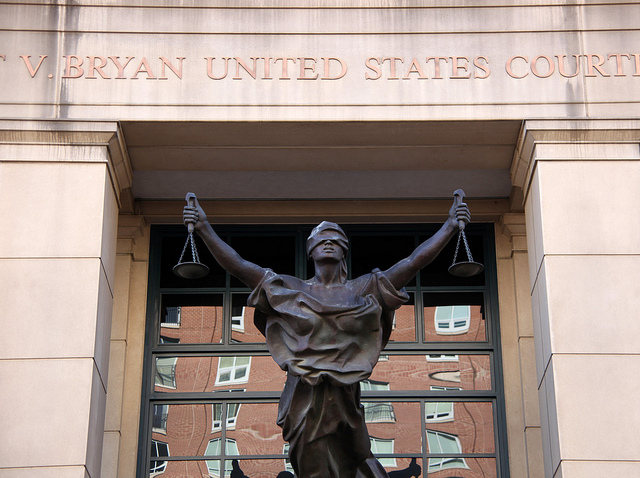By: MARIAN CROTTY

The courtroom is on the fifth floor of a large stone building that was once the Baltimore post office—a stuffy room with thick blue carpeting and walls of wood paneling, several Xeroxed signs reminding us not to chew gum, and long pew-like benches where we crowd together and grumble about how inconvenient it would be to serve on a jury. After we are sworn in, the judge instructs us to stand if certain statements apply to us, and I’m surprised by what people will admit. Would you believe something simply because it was said by a police officer? Would you assume that because someone has been charged with a crime, he must be guilty? I stand once for a question about having been the victim of a crime, but I feel uncertain about it. Stolen bikes in Phoenix, a break-in in Tallahassee. Do these count? Actually, the judge says, in our bench conference, those are not minor crimes. Did I get my stuff back? No. Do I blame the police for this? No. I go back to my seat. I want to stand for the question about having a relative who works in the criminal justice system, but the question is about people working in Maryland and so I don’t. I also do not stand when the judge asks if we have especially strong emotions about any of the charges in the case, which include firearms, illegal drugs, and animal cruelty. What does he mean byespecially strong? Stronger than I feel about other crimes? Or, stronger feelings than those of the average person who also finds animal cruelty horrific? And so, I am juror number ten.
Mostly, over the course of the next two days, there’s waiting—for the trial to start, for the security line, for each and every objection that ends with a discussion at the judge’s bench while static blares through the speakers. We wait for the prosecutor and the defense attorney to repeat themselves, to collect their thoughts, to shuffle through their paperwork. About twice a day, we sit in the jury room for more than an hour, waiting to be called. Don’t go to sleep, the court clerk reminds us one day on the way into the courtroom. You can’t make a good decision if you fall asleep. The defendant is a slim black guy in his mid-twenties, though something about the way he stares around the room makes him seem younger. All six of the prosecution’s witnesses are police officers. All male and white, almost all between 5’9’’ and 5’11”, about 190 pounds. Three of the six have blondish-brown crewcuts. From their testimony, which spans over most of two full days, we learn that several blocks in the city are under twenty-four-hour surveillance, that a search of this particular house recovered 200 capsules of heroin, marijuana, cocaine, an illegal firearm, and malnourished dogs, that the suspect was seen going into this house twice, for a few minutes, over the course of several weeks. We also learn that Baltimore City police officers are required to supply their own binoculars. From the defense, we hear one witness—the defendant’s mother who says that her son lived and currently lives with her, at a different address, on a different street. And then, after what feels like a brief glimpse into a larger more complicated story, we are sent back to the jury room to deliberate.
So far, I know the following about my fellow jurors: 1. An older black man works as a roofer and once fell from such a great height that he nearly died. 2. A mousy white woman in her thirties, who has spent every spare moment on her iPad or phone, oversees communications for a local university. 3. One of the alternates, a pretty light-skinned woman in her early twenties, has been to Comic-Con twice a year for the past three years. 4. A forty-something man with narrow impeccable braids and a quiet demeanor received news on the second day of the trial that the boyfriend of his niece was killed. 5. Two women in their fifties seem to know each other. And, because a fifty-something black man who is the most amiable and outgoing of the jurors got bored earlier and quizzed the group about various pop culture topics, I know that the vast majority of the group prefers Prince over Michael Jackson, has no interest discussing the Freddie Gray case in this setting, enjoys watching The Walking Dead, and possesses a surprising amount of knowledge about Michael Jackson’s son Blanket. Which is to say, when we enter the jury room for the last, I have no idea what to expect.
Our foreman, designated as such by the luck of his juror number, is a thirty-something blond man from Minnesota who has spent most of the trial scolding other jurors for discussing the case and for not lining up according to their juror numbers. He’s upset now that people aren’t all sitting down around the table as quickly as he would like. When he calls us to order and says we can begin to discuss the charges, I’m surprised to hear him express doubt. I had been worried that I was the only one. These were the jury instructions, he says, and I’m not sure the state has met the burden of proof. We go through the charges, one-by-one, all twenty-six. I’m impressed by the details people remember, the careful notes they’ve taken, and I’m grateful and surprised that we all seem to agree. Whether or not we think the defendant was guilty, the state didn’t meet the burden of proof for any of the charges. After we go back to the courtroom and read through each of the charges, the mood lifts. It is not just that we are free to go home or that we have apparently spent the past three days in the company of reasonable people—we have, in good conscience, been able to spare someone. If he’s in the life, one of the male jurors says in the elevator, he’ll get caught. He’s smiling like he got away with something, but he didn’t, an older woman says. That’s true, we all say, that’s true, though we are all smiling like we got away with something, too.
Marian Crotty is the Assistant Editor of The Common. Her short stories have appeared or are forthcoming in literary journals such as the Southern Review, the Kenyon Review, and the Alaska Quarterly Review. Her personal essays have appeared in journals such as the Gettysburg Review, the New England Review, and the Michigan Quarterly Review. She has received scholarships to attend the Sewanee and Bread Loaf Writers’ conferences and fellowships from Yaddo, The Camargo Foundation, and a research grant to The United Arab Emirates.



